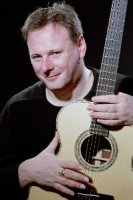 Pat Ragains: It's October 19th, 2008, and I'm interviewing Tony McManus in Elora, Canada.
Tony, how do you develop your guitar repertoire?
Pat Ragains: It's October 19th, 2008, and I'm interviewing Tony McManus in Elora, Canada.
Tony, how do you develop your guitar repertoire?by Patrick Ragains
After pursuing music full-time since the mid-1990s, Tony McManus is experiencing a career and
creative watershed. He maintains a demanding touring schedule, performing concerts both solo and in special
groupings with artists like Bruce Molsky and Beppe Gambetta, teaching workshops and recording. Recently he
received Acoustic Guitar's 2008 Players' Choice Gold Award for best Celtic guitarist. Inspired by the playing
of Tony Cuffe, McManus employs little-used right-hand techniques to play melodic ornamentations that are
characteristic of Irish and Scottish fiddlers and pipers. He also plays music from other traditions,
including Monteverdi's "Sì Dolce è'l Tormento (on the new Maker's Mark CD ) and the Jewish song, "Shalom
Alecheim", the latter learned from a recording by mandolinists David Grisman and Andy Statman. McManus
also seamlessly weaves contemporary music into his performances, often playing Richard Thompson's "Pharaoh"
(one of the few tunes he sings in concert), "What a Wonderful World", and Charles Mingus' "Goodbye, Porkpie
Hat." The common elements in such a wide choice of music are McManus' good taste, wide dynamic range, and clear
tone, all served by his prodigious technique.
In the following interview Tony McManus discusses his life in music and the recording of
The Maker's Mark.
I interviewed Tony in Elora, Canada, at the site of a weekend workshop, which he co-led with Rolly Brown.
McManus taught representative tunes and techniques in depth, while Rolly Brown covered some music theory,
using it to develop lead lines and play interesting, pianistic accompaniments on acoustic guitar. The workshop
also included a presentation by Ottawa luthier Linda Manzer and a public concert by McManus and Brown
(who performed solo and together).
 Pat Ragains: It's October 19th, 2008, and I'm interviewing Tony McManus in Elora, Canada.
Tony, how do you develop your guitar repertoire?
Pat Ragains: It's October 19th, 2008, and I'm interviewing Tony McManus in Elora, Canada.
Tony, how do you develop your guitar repertoire?
Tony McManus: A lot of it is based on tunes that I've been listening to since I was a kid. I grew up in Scotland,
but of fairly strong Irish descent. I was two generations back, from the north of Ireland, and one more generation
on my mother's side, you're in Sligo, over in the west. So I grew up with a fairly hefty Irish cultural endowment,
so to speak. And that's the guts of my repertoire still, to this day. The album I've just recorded, there's a
bunch of tunes there I've been listening to since I was a kid. And through travelling with various ensembles all
over the world, you come into contact with musicians and other music. So, you know, I play some tunes from
Scandinavia, some tunes from eastern Europe, some tunes from Brittany and Spain, and elsewhere. So, I'm always
on the lookout for new stuff. I'm not determined in any way, just to play Celtic music, so, on this new album,
there's stuff from all over the place. But the guts of it is basically the music I grew up with.
PR: How did you pick the material for the Maker's Mark CD (i.e., Dream Guitars)?
TM: It's a mixture. Some of it... tunes I've been playing for a long time and haven't recorded. Some of it, I
deliberately sat down and thought, "It'd be great to put another set of bagpipe tunes together," and picked a
couple of favorite tunes, like the Inveran and ones like that. A couple of tunes I'd heard from different
musicians in Scotland. I thought it'd be great to try to arrange those on guitar. And other tunes were specifically
chosen for different instruments. There are two tunes on different baritone guitars. The African anthem
tune - Nikosi Sikelele - I first heard that when I was a student. It was a liberation song of the anti-apartheid
movement, which I joined when I was seventeen. And now, it's the South African national anthem! So, that's a
great joy for me- I love playing that tune, just because of the history. It's gone from being this song of
protest to, not a victory cry, but it's an affirmation of humanity, if you like. The words that go along with
it just basically mean "God bless Africa." And it's not a nationalist thing at all. It's not limited to South
Africa - it's sung all over the continent. So, there's a political element to that tune. The other tune on a
baritone guitar is a piece by Donald Lunney that I heard in the eighties. It's this beautiful, meandering
tune. It just goes up and down - there's no rhyme or reason to it, and hence, he called it "Coast River,"
and... this image in his head of a river, just goin' whichever way, to the sea, if you like. And so, that tune,
because of the key it was written in - I didn't want to change the key it was written in. It just seemed to sit
very nicely on a baritone guitar. So that's why that one happened that way.
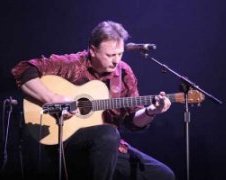 PR: The same register - the same octave?
PR: The same register - the same octave?
TM: Yeah. It just gives you access to these really beautiful, growling bass notes, and at the same time, the
melody's firing up and down the top two strings. So, that's the reasoning behind that one. Let's see, what
else is on that one? The "Valse des Bélugas," my friend Andre Marchand composed that one. Andre's from Joliet
in Quebec. He doesn't write very many tunes, but they're all crackers. This is my third solo album in a row
with an Andre Marchand tune.
The thought process behind the album was to do a whole bunch of tunes on different instruments. So,
there's a different guitar on each track. And then, the last track - I always think the last track on an
album should be different. Like in a live performance, I think the encore should be different. If you're
not gonna come back and do something different, well then, why didn't you do it in the body of the gig? It
should always be something outside of your normal repertoire, something lighthearterted, or something a bit
different. So, for the last track on the album, I thought, "Well, let's use all of the guitars." Because
everything else is solo, there's no overdubs, there's just me and a guitar and a bunch of microphones. So,
for the last track, I thought, "Well, let's play with the studio and use all of these beautiful instruments."
So, on the last track was fifteen guitars and nothing else (laughs). So, I recorded one after the other, and
we spent a day just trying to get our heads around it and mix it. And it was still in the rough mix stage when
I had to fly home. I just left it in the hands of the engineer and said, "Do what you can." And he - I had a
notion to go back to Nashville for a day, and just tidy up, but he sent me what he thought was the definitive
mix, and I agreed. But it's quite a task to put fifteen of the same instrument on one piece of music and not
have it sound like a train wreck! The way it works is that there's different guitars coming in at different
points through the tune. And at one point it drops down to just this beautiful nylon-string guitar, which takes
the melody a couple of times, and then it builds back up. And we have lots of rhythm parts and lots of melody
parts and some improvised bits. So, it's a nice way to finish the album.
PR: When you use something like the sitar-guitar, what leads you to choose that- are you just experimenting?
TM: Well, I went to Linda Manzer's workshop in Toronto and spent an afternoon drinking tea and looking at amazing
guitars that she had. She is so in demand as a builder, it's very rare to actually find a Manzer that's unsold.
And she had three or four instruments in her workshop that were finished. And this one in particular, it'd become
her exhibition guitar. It was an instrument she'd take to all the trade shows and all the luthier's exhibitions
in Healdsburg, it's a Rhode Island guitar show, and there's one in Montreal. So that guitar would go to various
shows, and she would lend it out to people. I think Bruce Cockburn had it just before I got my grubby mitts on it.
But it and I just instantly bonded; I just loved the nuance of that instrument - it's a very unusual guitar. The
bridge has six bone blocks that are about an inch long. And the strings vibrate - they go over these blocks, flat.
There's no bridge, theres' no saddle, so to speak, there's no sharp point for the string. And it buzzes. It's
exactly the principle behind a sitar. As soon as you mention a sitar to a guitar player, people start thinking of
sympathetic strings, you know and how many sympathetic strings. It doesn't have any! And the sympathetic strings
on a sitar are kind of icing on the cake, but the cake itself is the flat bridge, which no one notices. That's what
gives the sitar its sound. So, Linda took that principle and applied it to the guitar, and refined it and toyed
around with various designs for the bridge. She showed me all the stages it went through and its evolution. And
I played it, and we both sat there thinking, "Whoa, that was really good!" And she's thinking, "Whoo! That guitar
really should be his." So we went backward and forwards for awhile, and she brought it to a gig. I did a solo show
at a church in Toronto, and she brought the guitar. And we still hadn't agreed a price at this stage. I played the
guitar during the gig, and she said, "Well, take it home with you and let me know what you think. And as soon as
she said, "Take it home with you," well, there's no way you're gonna get it back. So, now I have it. (laughs)
PR: When you choose to play a tune on it, is it just because you're experimenting?
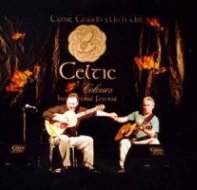 TM: Yeah, I'm still trying to get my head around it. It doesn't suit being driven very hard, or if you do try
and drive it hard, you get a very staccato. If you want the ringing, nasal sound, you have to play it very gently.
So it suits a certain type of tune, you know. The few things I've played on it live tend to involve either funny
time signatures or funny scales. There's "The Last Dance," a Greek wedding tune that I recorded with Alain
Genty - not on that guitar, but when I play it live, I use that guitar now. It seems to suit that bit of
strangeness, either in the time signature or in the scale.
TM: Yeah, I'm still trying to get my head around it. It doesn't suit being driven very hard, or if you do try
and drive it hard, you get a very staccato. If you want the ringing, nasal sound, you have to play it very gently.
So it suits a certain type of tune, you know. The few things I've played on it live tend to involve either funny
time signatures or funny scales. There's "The Last Dance," a Greek wedding tune that I recorded with Alain
Genty - not on that guitar, but when I play it live, I use that guitar now. It seems to suit that bit of
strangeness, either in the time signature or in the scale.
PR: You use DADGAD a lot.
TM: Yeah, I use DADGAD and others, but I use DADGAD a lot.
PR: I mainly play in standard tuning, like a lot of people do. I wonder, when you're in DADGAD, playing a
pop tune like "Wonderful World," or a jazz tune like "Porkpie Hat," what advantages are there? Or are there any?
TM: Good question- maybe none! My arrangement of "Porkpie Hat" has generated as lot of comments, and mostly
favorable. But I listen to serious jazz players, playing that tune and (I think) "What the hell am I doing?"
What it is, is basically, a traditional musician, or a person like me, who plays traditional music, applying
that knowledge and that feel to a tune outside of that idiom. And what comes out isn't jazz, I don't really
have the knowledge to do that - the knowledge of chord structure that Rolly (Brown) has just been imparting
(at the Elora workshop). I didn't grow up in that tradition, so, when I play "Porkpie Hat," what comes out is a
slow air. That's the style of the tune; it just happens not to be one.
PR: You mean, you play it as an arranged song.
TM: Yeah. It's not jazz. Why DADGAD? Most of these things begin with an accident. Both of the tunes you
mentioned. I was playing one day in DADGAD - happened to have the capo on the first fret, which puts you
into Eb territory - and I hit the first three or four notes of that tune, almost by accident. And I said,
What the hell is that?" And it just triggered something, and I said, "Oh God, yeah, it's 'Porkpie Hat.'"
I first heard that tune through Joni Mitchell (Mingus,). I'm a huge Joni fan, and she recorded that. She put
words to the tune. I first heard it when I was a kid. That album came out in 1979 - I was fourteen, and I had
no idea about jazz. I knew that Mingus had written the melody. But I didn't know that it was already known,
and almost a standard. And it was her initial recording that exposed me to that tune, and others of Charles
Mingus. So, when I hit those first few notes, it just triggered that memory, and it was her, singing on it
(that I remembered). So, I went back and - by that stage, I had the original recording as well - that album...
(Mingus Ah Um, 1959) stuck that on, and just tried to figure out how it would work in DADGAD, and at three or
four different stages I thought it was gonna hit the wall. To be honest, the tuning doesn't really lend itself
to that type of chord structure, and there's three or four places where you have to pull a rabbit out of a hat...
PR: With the harmonics?
TM: Yeah, exactly. You have to play the melody note as a harmonic, because the bass note is, you know, three
quarters of a mile away, down at the first fret or something. So, it was a bit of a challenge, but I'm glad it
came to fruition in some sense. I'd love to explore the improvised section a bit more. It's not a very strong
part of my toolkit; I'm not a great improviser. So when I listened to the original Mingus recording, I arranged
a chunk of the sax solo. I'd love to push that a wee bit further, get some more mileage out of it, or apply it
to some other tunes.
 And "Wonderful World" was a similar kind of thing. I was just noodling with little triads on the top three
strings, just playing scales up and down in DADGAD. And again, it triggered something in the subconscious.
I said "What could it be?" and thought, "Oh, that might work." And then had a fairly cod arrangement of the
tune within a few days. And I was horrified, I was asked to play it back in July, at the Chet Atkins convention
in Nashville, and Frank Vignola was just about to come on. And I thought, "Oh, there's a real jazz guitarist.
What am I doing? Please take me out of here!" But it's good fun to go from that, you know, very well-known,
very beautiful tune, into a couple of traditional tunes, and then hit the punch line by going back to
"Wonderful World" at the end. So again, that's the last track on my first album. That's a kind of encore tune,
if you like. So, (I play) something completely different to what you've heard up to there.
And "Wonderful World" was a similar kind of thing. I was just noodling with little triads on the top three
strings, just playing scales up and down in DADGAD. And again, it triggered something in the subconscious.
I said "What could it be?" and thought, "Oh, that might work." And then had a fairly cod arrangement of the
tune within a few days. And I was horrified, I was asked to play it back in July, at the Chet Atkins convention
in Nashville, and Frank Vignola was just about to come on. And I thought, "Oh, there's a real jazz guitarist.
What am I doing? Please take me out of here!" But it's good fun to go from that, you know, very well-known,
very beautiful tune, into a couple of traditional tunes, and then hit the punch line by going back to
"Wonderful World" at the end. So again, that's the last track on my first album. That's a kind of encore tune,
if you like. So, (I play) something completely different to what you've heard up to there.
PR: You were talking yesterday about playing with the Nashville Chamber Orchestra. How do you approach that?
Did they prepare in advance?
TM: (Laughs) Yes. That was very scary. I've done it now, four or five times, and each time it's less scary, but
those are some serious, serious musicians. The Nashville Chamber Orchestra is basically a bunch of Nashville
session players who get together. There's a financial structure and a management structure, but they're Nashville
session musicians. It's not a job for life, like if you're playing in the Toronto Symphony Orchestra,
that's your job. But they are very, very adventurous, and their musical director, Paul Gambill, is always
on the lookout for different things to apply his orchestra to. And they have a guitar festival, sponsored
by Gibson, and they already have had another festival going. But I met John Jorgenson in Italy for the first
time, a few years ago, and we got on immediately. He's a very dear friend. He was flying back to the States,
I was flying back to Toronto, and he was saying, "We should try and involve the orchestra. And he emailed me
a week later to confirm, and I was thinking, "Holy shit, I don't know if I can play with real musicians!"
The way it works, it wasn't the full orchestra, I think I had eight musicians, and I sent a copy of each
CD to their artistic director, and he picked, I think, four or five tunes from my three albums at the time,
and gave them to different arrangers. The one that really worked for me was Don Hart - Grammy Award-winning
Nashville string arranger. And I went down to the Belcourt Theater and played the first half of the gig, and
John did the second half, and it was just fabulous. We had one rehearsal and I couldn't believe how fast these
guys are, because they're reading, sight-reading music, essentially. And if there was anything that I needed to
change, it would come to a halt, the score would go off, and someone would edit it, change it, and back it would
come, and we'd play it again, and it would be just fine. One rehearsal, the day before a long sound check, and
that was it - we're off! But it was great. It was very, very scary, but it went very well. I think we did it
twice in Nashville; we did another gig in Indiana, again with John Jorgenson. And then he asked me to do a
series of concerts, called the Acoustic Café - different venues around Nashville. We also played in Franklin,
Tennessee, just south of the city. And we took another bunch of tunes - we had the existing arrangements,
they took another bunch of tunes, arranged those, and it was all Don Hart this time, it was great. And I
had two guest, I had Bruce Molsky, who was in exactly the same head space as me, he's saying, "God, I don't
know if I can interact with these classical musicians!" And the thing that broke the ice was that the first
violin came over and said, "I've wanted to meet you for ages, I've been a fan of your music for years." And
Bruce went, "Shit!" And immediately, he's as relaxed, and played like a demon. It was fantastic. And the
other guest was Beppe Gambetta. And so they arranged, they took a piece from Bruce and a piece from Beppe,
and we all guested on each other's stuff. It was just fabulous.
PR: Is any of that recorded?
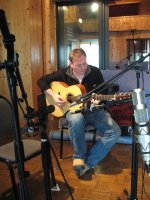 TM: Yeah, that gig was recorded. I don't know if any of it'll appear. I think one track of it might appear on a
Nashville Chamber Orchestra album, which would be cool. But part of the deal is, you get to keep the charts, so
I've managed to do this gig a couple of times elsewhere. We did it in Glasgow, a couple of times at the Celtic
Nations Festival. We played the same music, but with different string players, and I hope to do it again. It's a
very different feel, very different type of gig, but very exciting, very challenging.
TM: Yeah, that gig was recorded. I don't know if any of it'll appear. I think one track of it might appear on a
Nashville Chamber Orchestra album, which would be cool. But part of the deal is, you get to keep the charts, so
I've managed to do this gig a couple of times elsewhere. We did it in Glasgow, a couple of times at the Celtic
Nations Festival. We played the same music, but with different string players, and I hope to do it again. It's a
very different feel, very different type of gig, but very exciting, very challenging.
PR: You've talked about playing in the Celtic tradition, and that being a major focus for you, although I hear
you pushing the envelope harmonically, rhythmically, and with different tonalities. Do more conservative
musicians react well to that?
TM: Yeah! I've often had this kind of stereotype in my head that there's this big body of traditional music that
is very conservative, and you don't rock the boat. I haven't encountered that to any great extent. For example,
one of the nicest experiences I had was, I played at the Piping Center in Glasgow, and pipe major
Allan MacDonald - he was the Queen's piper - heard me playing a piobreachd (pronounced peebroch) on
the guitar ("The Lament for the Viscount of Dundee"). I'm sure there would be some pipers who'd be
absolutely horrified at the very notion of playing bagpipe on anything other than bagpipes. And Pipe Major
MacDonald's comment was that "You'd make a great piper." And it was really sweet, because it rang a bell
with me instantly. Seamus Ennis had said something almost identical to Arty McGlynn, who's one of my heroes,
as is Seamus Ennis - Ennis was the great folklorist and Uilleann piper. He did a lot of stuff for the BBC,
created a huge archive of field recordings at BBC, and heard Arty McGlynn playing jigs and reels on the guitar,
and said, "That's great piping! (laughs) And there was MacDonald, saying essentially the same thing to me.
I thought it was very sweet. So, I haven't really encountered this conservative strain of traditional
fundamentalists, and I think it's exaggerated in my head and a lot of other people's, too. It's a living,
breathing thing; it's changing all the time. Some of the most innovative musicians - people like Martyn
Bennett and others - the reason they can push the envelope is because they've got a very firm grasp of the
guts of the tradition. You can't expand on something you don't really understand. So, the musicians who
are really driving it forward are always people who can play it straight at the drop of a hat. People like
Gordon Duncan - I play a few of his tunes and I actually produced what was his last album - he 's no longer
with us. Gordon was very experimental in using half-notes on the pipes - like chromatic - notes that don't
really exist on the Highland pipes, and he would find a way of fingering C natural and F natural, and it
immediately jumps out at you, 'cause it's not within the scale - you know, from that instrument. But he
grew up as a straightforward pipe band piper, so he had a foot in that tradition, and understood it, and
played it brilliantly, as well as pushing the thing forward. I think that's almost always the case for real
innovative musicians are always people who understand the thing that they're moving on. Someone like Jaco
Pastorius, who invented the fretless bass, he also had a huge knowledge of big band jazz, like before doing
the new stuff. I put a lot of energy into trying to understand exactly how fiddle players and flute players
and traditional singers ornament their music, before trying to do it on guitar. So, a lot of it has to
do with having a handle on the guts of it.
PR: What would you like to do musically that you haven't done yet?
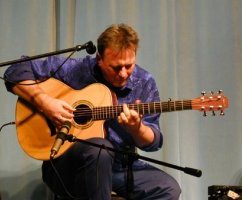 TM: There's lots... hanging out with someone like Rolly, it just points out big gaps in your knowledge, and I'm
entirely, self-taught, which is good and bad. It's good in the sense that you come up with techniques that aren't
in the book, and at some stage they might be. You know, backstrokes with the thumb and triplets with the thumb,
frailing, applying banjo techniques to guitar. That kind of thing just arises from working on your own,
trying to solve problems. On the other hand, there are huge gaps, you know? And the more I interact with
musicians from different genres of music, I think, "Geez, I've no idea about a lot of this stuff." And so,
I'd love to fill in some off those. I'd love to be a better improviser. Jazz musicians impress me to no end,
because of their technical knowledge, coupled with the ability to improvise. And that, to me, is the perfect
combination, and I'm not even close. That's something I'm working towards. I read an interview with Pat Metheny,
who's one of my heroes, and he was talking about reading (standard music notation). Now, I've read several
interviews with Pat, where he is entirely focused on the importance of being an improvising musician, and
that's basically what we have to be. In this interview he was stressing the importance of the ability to
read, which I thought, initially, was a little contradictory, but it's not. That's something I would have
to works towards. So there's always room for improvement.
TM: There's lots... hanging out with someone like Rolly, it just points out big gaps in your knowledge, and I'm
entirely, self-taught, which is good and bad. It's good in the sense that you come up with techniques that aren't
in the book, and at some stage they might be. You know, backstrokes with the thumb and triplets with the thumb,
frailing, applying banjo techniques to guitar. That kind of thing just arises from working on your own,
trying to solve problems. On the other hand, there are huge gaps, you know? And the more I interact with
musicians from different genres of music, I think, "Geez, I've no idea about a lot of this stuff." And so,
I'd love to fill in some off those. I'd love to be a better improviser. Jazz musicians impress me to no end,
because of their technical knowledge, coupled with the ability to improvise. And that, to me, is the perfect
combination, and I'm not even close. That's something I'm working towards. I read an interview with Pat Metheny,
who's one of my heroes, and he was talking about reading (standard music notation). Now, I've read several
interviews with Pat, where he is entirely focused on the importance of being an improvising musician, and
that's basically what we have to be. In this interview he was stressing the importance of the ability to
read, which I thought, initially, was a little contradictory, but it's not. That's something I would have
to works towards. So there's always room for improvement.
PR: What about recording projects?
TM: Well, I'm just about to go into the studio with a quartet called Strung, with April Vertch, who's a great
Ottawa Valley fiddle player. Growing up where I did, certain parts of Canada were very important. Lots of
people played French Canadian music - Québécois music, and growing up in Scotland, Cape Breton Island, in
Canada, is very Scottish. And they have a style of playing Scottish fiddle music that's very different to
the tradition in Scotland. It's the same music, but they play it a very different way. So, that part of
Canada is very important. You tend to forget, the country's huge, and there are other styles that aren't
related to what you grew up with. So, Ottawa Valley fiddle playing is what April does, and it's great. I
mean, she's also influenced by things like Texas swing and bluegrass, and a very versatile musician. So, I'm
looking forward to working with her, and Doug Cox, from British Columbia, a slide player.
PR: A slide player?
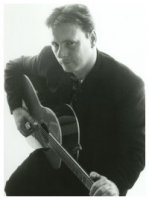 TM: Yeah, Dobro, and slide guitar and fiddle and my guitar and double bass (comprise the group). So that's the
next project, that's just coming up. There's a plan to work, to do a duo CD with Beppe Gambetta, which I think
would be great. There's a little jazz label in Chicago that's expressed an interest in recording us. I'd love to
record with Beppe and a great jazz rhythm section, just basic drums and bass. I think that would be very
cool - very different sound for me, and very challenging. That may be the tail-end of next year. At the minute,
I think the priority is getting this album of mine out, with all these huge, multiple guitars (Maker's Mark) .
That album is basically a celebration of where the guitar is at today. The standard of guitar building and the
quantity of great builders out there is just phenomenal. I spend a lot of time with fiddlers and mandolinists. The
violinists are always harking back to Cremona in the 1600s - that's the golden era, you know, that Stradivari,
Guarneri, all those guys... Amati... The mandolin players are always harking back to 1923, 'twenty-four, when
Lloyd Loar was working for Gibson - that's their golden era. For us, the golden era is right now, I think. The
vintage stuff is beautiful - it's lovely. The vintage market drives me insane, because it's just silly. If
you've got an old Martin guitar with cranky machine heads, you replace them with beautiful new Waverlys, the
value of the guitar will sink. And to me that's just insane, because it's no longer about an instrument, it's
no longer about the music you can make with it. It's something else, entirely, that's of no interest to me. So,
all the guitars on this new album are new - they're contemporary. I had a chance to record on one of three
D'Aquistio nylon string guitars, but decided not to, and used a Paul McGill, because he's still making, and
that's the guts of what he does, is make nylon-string guitars. Because D'Aquistio was known for making archtops,
so it wasn't representative of his work and, sadly, he's no longer with us. So I opted for a McGill from Nashville,
which is a beautiful guitar. I'm no expert on nylon strings, but something about that guitar was phenomenal.
So it was great fun to make this record and I hope people enjoy it. So we're just working on putting the sleeve
notes together, and photographs. There's a lot of information, both on the tunes and on the instruments and on
the builders of the instruments. There's different layers of information that has to go in this sleeve.
TM: Yeah, Dobro, and slide guitar and fiddle and my guitar and double bass (comprise the group). So that's the
next project, that's just coming up. There's a plan to work, to do a duo CD with Beppe Gambetta, which I think
would be great. There's a little jazz label in Chicago that's expressed an interest in recording us. I'd love to
record with Beppe and a great jazz rhythm section, just basic drums and bass. I think that would be very
cool - very different sound for me, and very challenging. That may be the tail-end of next year. At the minute,
I think the priority is getting this album of mine out, with all these huge, multiple guitars (Maker's Mark) .
That album is basically a celebration of where the guitar is at today. The standard of guitar building and the
quantity of great builders out there is just phenomenal. I spend a lot of time with fiddlers and mandolinists. The
violinists are always harking back to Cremona in the 1600s - that's the golden era, you know, that Stradivari,
Guarneri, all those guys... Amati... The mandolin players are always harking back to 1923, 'twenty-four, when
Lloyd Loar was working for Gibson - that's their golden era. For us, the golden era is right now, I think. The
vintage stuff is beautiful - it's lovely. The vintage market drives me insane, because it's just silly. If
you've got an old Martin guitar with cranky machine heads, you replace them with beautiful new Waverlys, the
value of the guitar will sink. And to me that's just insane, because it's no longer about an instrument, it's
no longer about the music you can make with it. It's something else, entirely, that's of no interest to me. So,
all the guitars on this new album are new - they're contemporary. I had a chance to record on one of three
D'Aquistio nylon string guitars, but decided not to, and used a Paul McGill, because he's still making, and
that's the guts of what he does, is make nylon-string guitars. Because D'Aquistio was known for making archtops,
so it wasn't representative of his work and, sadly, he's no longer with us. So I opted for a McGill from Nashville,
which is a beautiful guitar. I'm no expert on nylon strings, but something about that guitar was phenomenal.
So it was great fun to make this record and I hope people enjoy it. So we're just working on putting the sleeve
notes together, and photographs. There's a lot of information, both on the tunes and on the instruments and on
the builders of the instruments. There's different layers of information that has to go in this sleeve.
PR: Thanks, Tony!
TM: Thank you, Pat. I appreciate your coming here!
© 2009 Patrick Ragains
Here's a partial discography for Tony McManus: